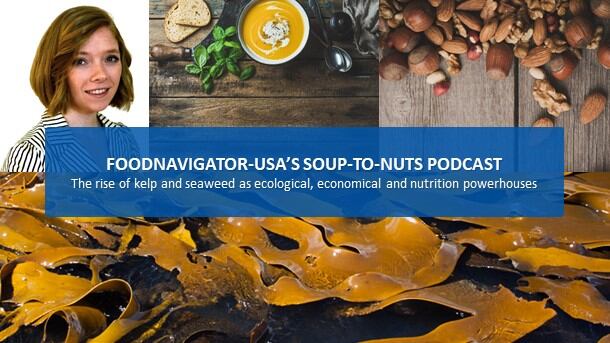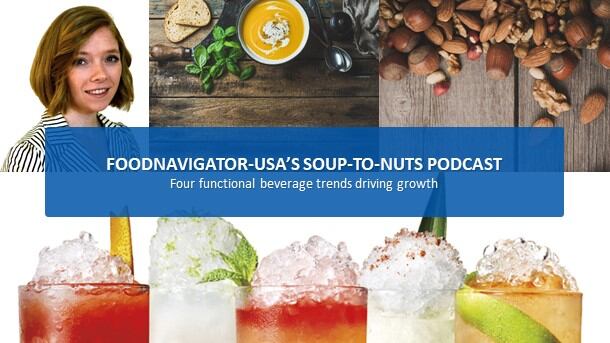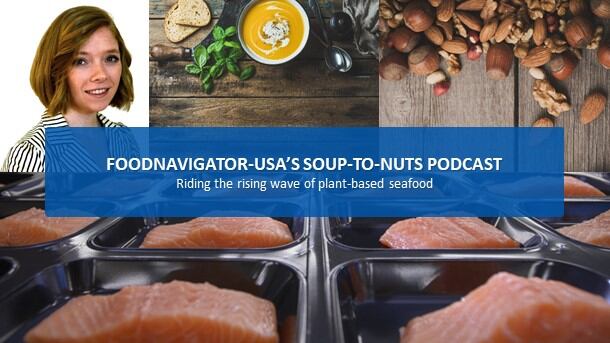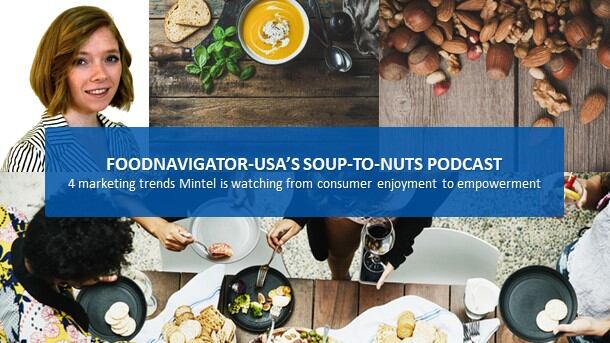Seaweed and kelp are versatile, nutrient dense ingredients with a wide range of flavors, textures, colors and applications – but most of that is lost on Americans because the majority of seaweed sold here is imported dried and later reconstituted with artificial dyes. Or it is included among a laundry list of other ingredients in meat, bakery, plant-based and other products, where it is used to enhance flavors or for its gelling, texturizing and hydrating capabilities, but lost on consumers.
And while these properties are invaluable to the food and beverage industry, two Maine-based businesses – Atlantic Sea Farms and Ocean’s Balance – believe this is only a fraction of seaweed’s potential. They see it as the next wave of better for you eating, a more environmentally sustainable alternative to some of the monocrops that dominate Western diets and as a way to economically diversify and stabilize seasonal lobster farming in their state.
In this episode of FoodNavigator-USA’s Soup-To-Nuts Podcast, we catch up with the entrepreneurs behind Ocean’s Balance and Atlantic Sea Farms at Natural Products Expo West to take a deep dive into the sea of possibilities offered by American-farmed kelp.
[Editor’s note: Never miss an episode of FoodNavigator-USA’s Soup-To-Nuts podcast – subscribe today.]
No, it is not ‘that stuff from my beach’
While most American’s may have limited understanding of and experience with seaweed and kelp beyond seeing it on beaches, Atlantic Sea Farms’ director of sales Zoe Croft says many are eager to try it once they learn about its superfood status and diverse applications.
Croft acknowledges that most Americans think that kelp and seaweed is “that stuff from my beach,” but she says the fresh kelp Atlantic Sea Farms grows is “very different” as it is grown in the “clean cold waters of Maine in January, February and March in pristine, beautiful conditions” and is a “really tender, mild sea green.”
It is also a far cry from imported seaweed which, she says, accounts for 98% of what Americans consume and which is shipped to the US dried and then rehydrated with dyes “the same as Mountain Dew.”
Once this is explained, Croft says consumers and retailers are eager to learn more about and try these “superfoods” that she predicts are on a similar trajectory as kale a few years ago.
She adds that kelp and seaweed are packed with pre and probiotics, hard-to-find iodine, B12, potassium, calcium and “all these great minerals” that aren’t available in other formats.
The health properties of kelp and seaweed are driving many consumers to try them – that a push from health care providers, Croft said laughing.
To take advantage of and further magnify the nutritional value of fresh kelp harvested in Maine, and to make it easy for Americans to enjoy every day, Croft says Atlantic Sea Farms offers a wide range of ready to eat or low-prep options that easily fit into any meal or day part. These include a fermented seaweed salad made from fresh, never dried seaweed, kelp kimchi and several frozen products including a basic shredded and blanched kelp and smoothie cubes.
“We are in the thick of it right now and I’m trying to normalize kelp in a really important way,” by showing it tastes great and can go in everything, Croft said.
Lisa Scali, co-owner and director of sales and marketing at Ocean’s Balance, which farms seaweed in Maine, is also trying to normalize seaweed in the US, but rather than place it front and center like Atlantic Sea Farms, she prefers to tuck into everyday products so that it is accessible and less intimidating.
Ocean’s Balance does this by adding different types of seaweed into its award winning pasta sauce and spice blends. But for those already familiar with seaweed and kelp, it offers a kelp puree, and a wide range dried organic whole leaf and flake seaweeds, which she notes each have a different taste and nutrient profile.
Both companies also make their kelp and seaweed available as ingredients for manufacturers that want to incorporate them into their products and further elevate the category.
Environmental benefits
Seaweed and kelp aren’t just good for people, they are also good for the planet, according to Ocean’s Balance CEO Mitchell Lench, who explains that the environmental benefits of seaweed is a driving reason why Ocean’s Balance is in business.
“Our mission is to get more people eating seaweed because of the benefits it provides the ecology from a climate sequestration purpose as well as just from the zero-input crop where it takes no freshwater fertilizer or uses up land,” he said.
He added that because a certain percentage of farmed seaweed “fluffs off and sticks ot the bottom on the ocean,” researchers are looking into – are near convinced that – seaweed cold be cultivated for carbon sequestration.
While explaining the environmental benefits of seaweed to consumers is challenging, Croft says it is important because a growing percentage of shoppers factor sustainability into their purchase decisions.
“There is this growing trend of the climatarian and we’re all trying to eat for a better planet. And kelp is a climate hero because it acts like a sponge and its soaking up carbon and nitrogen from our local water columns, which helps reduce ocean acidification,” she explained.
Lench agrees, noting the combination of consumer interest in sustainability and seaweeds environmental benefits is a powerful market growth driver.
This is reinforced by market analysis from Grand View Research, which predicts the global commercial seaweed market, estimated to be worth $16.6bn in 2020, is on track to grow at a compound annual rate of 10.8% through 2028.
In the US, it predicts brown seaweeds, which are used for hydrocolloids and increased demand for healthy alternatives to calorie- and fat-rich foods, will grow 10.7% from 2020 to 2028.
Stabilizing local lobster economies
As demand for domestic seaweed and kelp grows, it also offers a powerful economic benefit that many consumers likely will want to support – creating a virtuous circle. This is one of the primary reasons that Croft said Atlantic Sea Farms was created.
“We’re mission driven … and we work specifically with lobster men and women to help diversify their income in their offseason. Kelp is an awesome winter crop that they can do alongside their traditional lobstering,” she said.
She explained that Maine’s once vibrant coastal economy is now almost entirely dependent on lobster, which means during the off season, finances can become tight. But Atlantic Sea Farms helps farmers obtain leases and gear and then provides them with free seeds.
Lench says Ocean’s Balance takes a similar approach – tapping lobster farmers to farm and wild harvest kelp and seaweed.
To help the nascent domestic kelp and seaweed industry take root and thrive, the US Department of Agriculture is investing heavily in the segment. Earlier this year, USDA awarded a $500,000 grant to the Gulf of Maine Research Institute to establish a comprehensive aquaculture workforce training system, and awarded another $500,000 to help increase seaweed and other sea product production in Southeast Alaska.
Between this funding, growing consumer interest and the deep passion of companies like Ocean’s Balance and Atlantic Sea Farms, the domestic seaweed and kelp industry have significant potential and will be a space to watch in the coming years.




